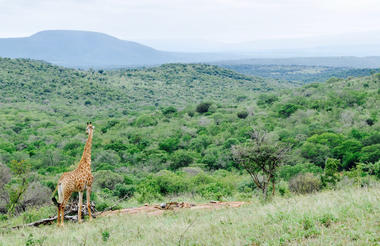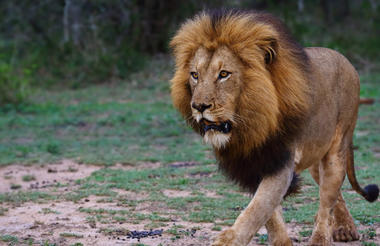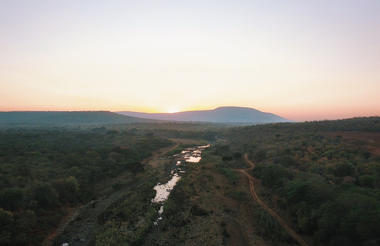You will be met on arrival at Durban's King Shaka International Airport by your photo guide and a transfer representative, and transferred to Amakhosi Safari Lodge. The transfer will take approximately 4.5 hours, with a comfort stop en route.
Check in at your private safari villa (2 bedrooms), additional rooms will be booked in the main camp, in the Luxury River Suites. Most rooms can be converted to offer 2 single, separated beds.
If you arrive latest 15h00 (3 pm), enjoy High Tea before going out on your first photo safari drive. For later arrivals, you may not arrive in time for High Tea and your gamedrive will be shortened. The drive will continue after dark, using spotlights to hopefully see some of the shy nocturnal creatures.
What to bring:
Camera DSLR / mirrorless
Lenses 300 mm or longer
Lens for landscape 16 - 35mm (preferably f2.8) - lenses need lens hoods
Cover for dust and rain
Tripod
4x Memory cards (32 GB or more)
Ideally also bring Laptop with Lightroom and / or Photoshop
Card reader
Lens cleaning kit
Note block and pen
Also important to consider:
Binoculars
Sun block factor 30 or higher
Cap / sunhat
Light walking shoes
Shorts
Swimming costume
Rain jacket
Warm jacket (fleece) - sitting on an open safari vehicle at sunrise can be chilly!
If travelling during winter (April - October), also bring windproof jacket and scarf. It can be very cold early morning and evening on the open safari vehicle!
It is essential that you travel with adequate medical travel insurance, which should also include special medical evacuation cover.



Amakhosi Safari Lodge is located in a Savannah biome, with the perennial Mkuze River running through the reserve. The reserve has a wealth of wildlife. A variety of antelope species; zebra and giraffe. As this is a Big Five reserve, it is home to elephant, rhinoceros, lion, leopard, buffalo. Cheetah sightings are frequent whilst not forgetting hippo and crocodile which provide nature lovers with a true untamed view of nature. Besides the larger and smaller mammals, their world is shared by a host of other creatures which makes up this ecosystem, each one as important as the other in the part they play.
There are also more than 400 species of birds in the area, depending on the seasons you will see many of Africa's iconic bird species. Colourful bee-eaters and kingfishers; majestic eagles and vultures; bird photographers are likely to get several "lifers" during the time spent at Amakhosi.
Conversation around the fire at night is of close encounters with lionesses and playful cubs, sand-bathing elephants and streaking cheetah. But equally engrossing are the adventurous guide’s encounters with smaller creatures, from delicate bark spiders to glossy dung beetles; and anecdotes about the trees and medicinal plants of the reserve.



Each day at your photo safari lodge will follow more or less this programme (excluding arrival and departure day):
Early morning Wake up with tea / coffees and snacks - Morning game drive: (3 hours)
A photo safari morning starts a little before sunrise! For many, this is a big challenge, but nevertheless imperative, in order to take full advantage of the golden morning light which embellishes most wildlife and nature images. This is also the time of day when most animals are active, so the mornings should give you some great opportunities for capturing striking images. Remember, there is more to wildlife photography than lions; e.g. "the little things"!
An early wake-up call is usually made approximately 30 minutes ahead of departure. This allows for a quick wash and a hot beverage just to get those creative juices flowing….
After a pre-check and briefing by your photo guide (including giving some suggestions for camera settings and a brief over-view of what to expect on the drive), we set off. Your guide is always available on the vehicle to provide constructive suggestions and individual help during the actual drive.
About midway through the morning drive we take a comfort / coffee break in a safe area, to allow guests to stretch their legs and enjoy a hot beverage and some biscuits/rusks etc
Your photographic guide will help you with the camera settings for each specific situation and condition. You need to understand the basic photography terms such as aperture, shutter speed, ISO, metering, drive modes, focus selection points, etc. It is also important to know where and when you should change these settings (with wildlife photography you may miss the special shot if you are fumbling with your camera looking for which button to adjust).
Topics of Importance for Wildlife Photography:
- knowing your subject (the more you know about your subject, i.e. animal, the more likely you are able to predict its whereabouts and actions)
- Getting the shot perfect in the field – without having to do lots of editing in Photoshop afterwards
- using RAW for maximum results
- how and when to use autofocus / manual focus
- controlling Depth of Field
- settings for night (low light) photography
- focusing on the eyes
- know what you want the image to say. Have the images got a special feeling? Do they tell a story?
- composition: Rule of thirds
- use a flash: during day and night
- mastering birds in flight
- importance of supporting your camera
The morning game-drive usually takes about 3 hours (depending on what we see), and we then return to the lodge for a delicious brunch / late breakfast.
Between Breakfast/Brunch and Lunch/High Tea
After breakfast, photo safari guests may retire to a quiet, private corner of the camp to assess the morning results. There will be free time or optional lectures on editing (Photoshop / Lightroom) as well as photography tips and tricks, depending on the group and their preferences. Edit images for the presentation of your best 3 images (which will be held after dinner).
What else? How about read a book, sleep or just sit still and listen to the sounds of raw nature?
Late Lunch / High Tea
We meet again early afternoon for a light meal, before setting off on the afternoon Game Drive (minimum 3 hours). Similar to the morning game drive, we try to find our subjects to photograph. The photo-guide will help you with some tips and tricks for sunset and night photography, and using flash and lights to enhance your shot. Just before twilight, a safe area is located for evening sundowners, where alcohol or soft beverages are served with lights snacks. (Drinks on the drive are usually pre-ordered before the drive sets out).
After sundowners, the guests will experience driving in darkness with a vehicle spotlight to find interesting animals/owls etc, then returning to camp.
Return to lodge after Sunset - Dinner
Time for a quick freshen up before we meet for dinner. Dinner could be a plated dinner, a buffet meal or a traditional African “Braai” (Barbeque) often served in an outside boma around an open fire.
After dinner we meet for maximum 1 hour. We will discuss and evaluate the 3 chosen images per photographer, from the last 2 game drives. These images are displayed for the group to see, with each image being discussed as a group and critiqued by your photo guide. It is NOT a competition, but an opportunity to learn by gaining an understanding of what constitutes a good image.
Bed time: a well-deserved rest after this exciting day in the African Bush. Remember, early start tomorrow!



A full day's photo safari programme similar to the previous days, but maybe with a very special sighting?



After your last morning photo safari, return for a hearty brunch. You will be collected by your transfer representative and transferred to Durban's King Shaka International Airport.

